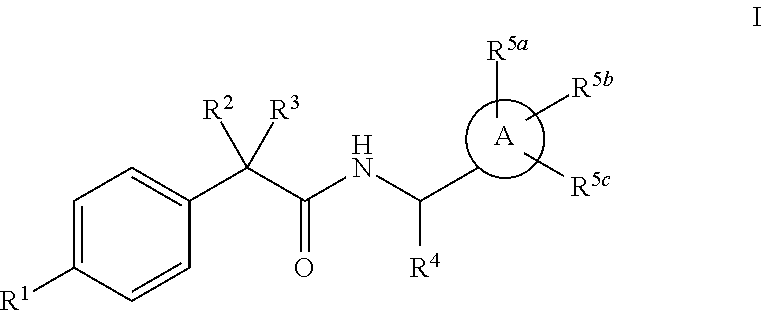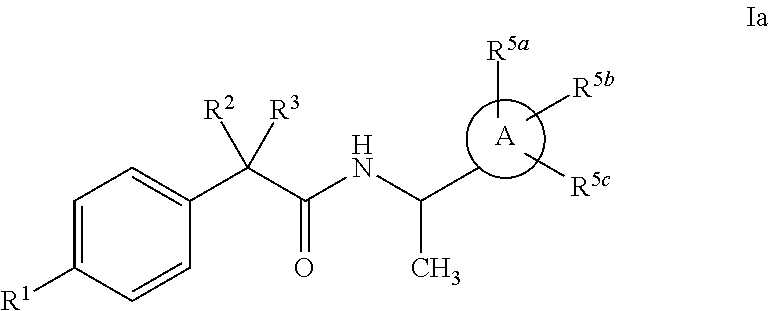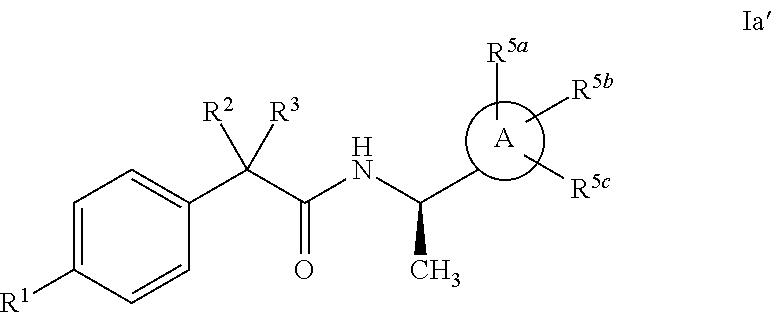Heterocycle amide t-type calcium channel antagonists
a calcium channel antagonist and heterocyclic compound technology, applied in the field of voltage gated channel proteins, can solve the problems of numerous problems in the known therapeutic regimen for such treating such diseases and disorders, and achieve the effect of treating or preventing
- Summary
- Abstract
- Description
- Claims
- Application Information
AI Technical Summary
Benefits of technology
Problems solved by technology
Method used
Image
Examples
example 1
[0193]
N—[(S)-(5-bromopyridin-2-yl)(1-methyl-1,1-1,2,3-triazol-4-yl)methyl]-2-(4-isopropylphenyl)acetamide
[0194]To a solution of N—((S)-(5-bromopyridin-2-yl){1-[(trimethylsilyl)methyl)-1H-1,2,3-triazol-4-yl}methyl)-2-(4-isopropylphenyl)acetamide (0.4 g, 0.80 mmol) in THF (5.0 mL) was added a solution of TBAF in THF (0.84 mL, 1 M). The reaction was stirred at room temperature for 1 h. The solvent was removed and the residue was purified by silica flash chromatography (gradient, 10-100% EtOAc in hexanes) to give N—[(S)-(5-bromopyridin-2-71) (1-methyl-1H-1,2,3-triazol-4-yl)methyl]-2-(4-isopropylphenyl)acetamide (0.22 g, 65%). ES-MS [M+1]+: 428.0. 1H NMR (CDCl3, 400 MHz) δ 8.53 (d, J=2.0 Hz, 1H), 7.76 (dd, J=2.4, 8.0 Hz, 1H), 7.4w (s, 1H), 7.36 (d, J=6.8 Hz, 1H), 7.23 (d, J=8.0 Hz, 1H), 7.22 (s, 4H), 6.26 (d, J=6.8 Hz, 1H), 4.01 (s, 3H), 3.62 (s, 2H), 2.94-2.85 (m, J=6.8 Hz, 1H), 1.25 (d, J=7.2 Hz, 6H). HRMS (ES) [M+1]+ calcd for C20H22BrN5O: 428.1081. Found: 428.1112.
example 2
[0195]
2-(4-isopropylphenyl)-N—[(S)-(1-methyl-1H-1,2,3-triazol-4-yl)(5-propylpyridin-2-yl)methyl]acetamide
[0196]N-[(5)-(5-bromopyridin-2-yl)(1-methyl-1H-1,2,3-triazol-4-yl)methyl]-2-(4-isopropylphenyl)acetamide (0.075 g, 0.18 mmol) was mixed with n-propylboronic acid (0.04 g, 0.44 mmol), PdCl2(dppf)2 (0.014 g, 0.019 mmol), Ag2O (0.10 g, 0.44 mmol) and K2CO3 (0.073 g, 0.53 mmol) and degassed. THF (3 mL) was added and the mixture was heated in microwave at 130 C for 30 min. The reaction mixture was diluted with EtOAc and filtered through Celite. The solvent was removed and the residue was purified by reverse HPLC to give 2-(4-isopropylphenyl)-N—[(S)-(1-methyl-1H-1,2,3-triazol-4-yl)(5-propylpyridin-2-yl)methyl]acetamide (0.035 g, 51%). ES-MS [M+1]+: 430.1. 1H NMR (CDCl3, 400 MHz) 8 1H NMR (CDCl3, 400 MHz) δ 8.29 (d, J=2.0 Hz, 1H), 7.58 (d, J=6.4 Hz, 1H), 7.45 (dd, J=2.4, 8.0 Hz, 1H), 7.40 (s, 1H), 7.27 (d, J=8.0 Hz, 1H), 7.24-7.19 (AN, 4H), 6.27 (d, J=7.2 Hz, 1H), 3.98 (s, 3H), 3.62 (s,...
example 3
[0207]
2-(4-cyclopropylphenyl)-N—{(S)-(1-methyl-1H-1,2,3-triazol-4-yl)[4-(2,2,2-ttrifluoroethoxy)phenyl]methyl}acetamide
[0208]To a solution of 2-(4-cyclopropylphenyl)-N—((S)-[4(2,2,2-trifluoroethoxy)phenyl]{1[(trimethylsilyl)methyl]-1H-1,2,3-triazol-4-yl}methyl)acetamide (0.065 g, 0.13 mmol) in THF (0.5 mL) was added a solution of TBAF in THF (0.14 mL, 1 M). The reaction was stirred at room temperature for 0.5 h. The solvent was removed and the residue was purified by reverse-phase HPLC to give the product as white solid. 1H NMR (CDCl3, 400 MHz) δ 7.22 (d, J=8.8 Hz, 1H), 7.13 (d, J=8.0 Hz, 1H), 7.02 (d, J=8.0 Hz, 1H), 6.85 (d, J=8.8 Hz, 1H), 6.76 (d, J=7.6 Hz, 1H), 6.23 (d, J=7.6 Hz, 1H), J=8.0 Hz, 2H), 4.03 (s, 3H), 3.66 (s, 2H), 1.90-1.84 (m, 1H), 0.97-0.93 (m, 2H), 0.69-0:65 (m, 2H). HRMS (ES) [M+1]+ calcd for C23H23F3N4O2: 445.1846. Found: 445.1861.
Intermediate 9
[0209]
N-[(1E)-(4-bromophenyl)methylidene]-2-methylpropane-2-sulfinamide
[0210]To a solution of 2.0 g (10 mmol) 4-bromobe...
PUM
 Login to View More
Login to View More Abstract
Description
Claims
Application Information
 Login to View More
Login to View More - R&D
- Intellectual Property
- Life Sciences
- Materials
- Tech Scout
- Unparalleled Data Quality
- Higher Quality Content
- 60% Fewer Hallucinations
Browse by: Latest US Patents, China's latest patents, Technical Efficacy Thesaurus, Application Domain, Technology Topic, Popular Technical Reports.
© 2025 PatSnap. All rights reserved.Legal|Privacy policy|Modern Slavery Act Transparency Statement|Sitemap|About US| Contact US: help@patsnap.com



